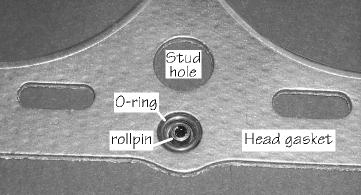
A roll pin

A roll pin |
| I |
My questions:
| A |

A roll pin |
Regarding Rich�s question #4 about using �tiny rings� to maintain the shape of the O-rings, at a tech session in April �92 Peter Krause was showing the tiny aluminum rings, which seemed pricey at the time; I forget the exact price, but my impression is that it was about $20 a set. Peter said he likes the idea because the rings offer less restriction to the oil passage, and he also was turned off by the irreversibility of the roll pin � easy to get in, very hard to get out. I asked whether he has ever seen evidence of head damage because of roll-pin oil passage restriction; he said no. So- it seemed to me to comes down to whether an undeniably neater way of doing things is worth an extra $20 or so, and also whether there were real advantages beyond conceptual purity. In my next letter to Fred Di Matteo I asked had he an opinion? Had he ever seen evidence of head damage because of roll-pin oil passage restriction starving the cams?
His quick reply enclosed a sample of his solution, which he had written about many years before and I had missed- or forgotten. In any event, it bears repeating. Let him tell it:
�The idea of using the roll pins to contain the O-rings is fine but the better method is to use brass tubing found in hobby shops which comes in various sizes. Cut to length, it makes the perfect solution for unrestricted oil passage. The existing oil holes in the cylinder block are drilled out larger to take the OD of the tubing. I like to match the oil holes in the cylinder head to the block holes and to allow the sleeve to enter the cylinder head by perhaps as much as a sixteenth or so. All that is needed is the right size drill in a drill press and a little common sense.�
As for head damage because of oil starvation, that which he had seen �might have been due to other factors a careless owner might not admit to�� but he thought not to roll pin restriction.
Joel Hailey, then Technical Advisor for International Auto Parts and now at Centerline, responded with a counter-argument. He questioned �why?� since he knows no evidence of oil starvation from roll-pin restrictions, questioned the corrosive combination of aluminum and brass, and was concerned about aluminum shavings winding up embedded in the bearings. He ends with �I don�t believe in creating a problem where there is none. Alfa Romeo recommends the roll-pin and O-ring technique, the validity of which has been proven by experience in the field. In this case I must say, �if it ain�t broke, don�t fix it�.�
The possible problem of corrosive linking of dissimilar metals with brass or copper in aluminum had occurred to me, and was mentioned in my original note. Water is a much better electrolyte than oil, though, and Alfa tolerates a copper radiators and oil coolers and many drain valves and other fittings, as well as bronze valve guides, so I don�t feel spooked by that. The question of where the shavings go is a fair one; I assume the answer isn�t harder (or the consequences worse) than for other shaving-producing operations.
The question is probably usually moot by now; Fred came up with his variation when he was still doing first head gaskets on cars built in the sixties and early seventies, and there are probably few old engines which haven�t been pinned by now - but there are some. (I know I have a few-)
On Rich�s question #3 about removing the old roll-pins, I can say that bits of metal into the sump wouldn�t be bad, given magnetic drain plugs, but there is no way I can see to get to the sump; the oil gallery has the oil pump gears at one end and bearings at all the other ends.
[I like both the aluminum ring and the thinwall tube, but the roll-pins seem to work quite well enough. In Rich�s case, with the roll-pins not protruding, I would probably go with the aluminum rings.]
| M |
One set is enough to do 2 Alfa 4-cyl head gaskets, with a few spares to account for clumsiness.
| O |
The modification was done at the suggestion of a well known Alfa mechanic, who�s name has been on this list many times. The thought is that keeping the oil pressure down in the bottom of the engine will help late in a race when the oil gets thin.
My friend drilled and tapped the Alfa head above 5 of the 6 roll pins. He inserted an Allen screw in which he drilled a 1/16 th hole. Drilling the Allen screw was the hard part. The left front hole on the driver�s side was left open as that is where most pressure is exerted from the drive chain...
His engine has been run very hard for several races without any problem. If you look at the cam bearings, they are just cut into the aluminum of the head. No babbet or other insert is used and there is no groove cut for full pressure oiling. There is no oil feed in the bearing cap. Cams turn half crankshaft speed and the pressure from the valve spring is not all the great compared to the stress on the crankshaft bearings. I conclude the cams do not need a great volume or pressure of oil.